Organizational Change Management Report: [University Name] Analysis
VerifiedAdded on 2023/05/30
|13
|3074
|246
Report
AI Summary
This report provides a comprehensive analysis of organizational change management, focusing on a hypothetical company's need to transition from a traditional to a learning organization. It addresses the need for change, evaluates the company using Systems Contingency and Organizational Life Cycle Models, and contrasts learning versus traditional organizations. The report applies Woolner’s 5 Stages and Senge’s 5-Disciplines to the case study, identifying the nature and end result of the required changes as incremental and transformational, respectively. It also incorporates the Action Research Model and suggests innovative strategies, including exploration and innovation roles. Furthermore, the report applies Kotter’s 8-Step Change Process and identifies five pillars of sustainable change, offering a detailed roadmap for successful organizational transformation. The analysis includes practical applications and recommendations to facilitate a smooth transition and achieve desired outcomes.
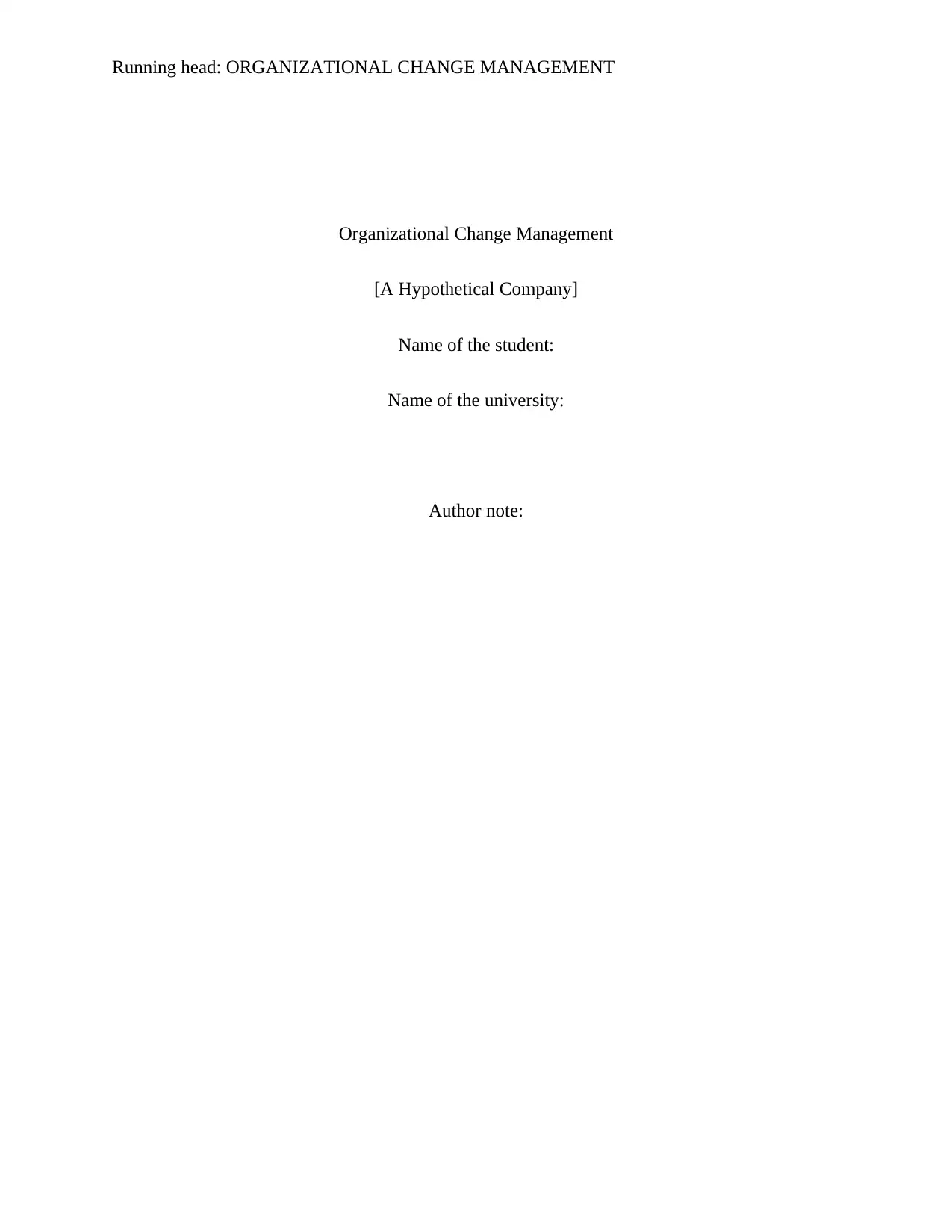
Running head: ORGANIZATIONAL CHANGE MANAGEMENT
Organizational Change Management
[A Hypothetical Company]
Name of the student:
Name of the university:
Author note:
Organizational Change Management
[A Hypothetical Company]
Name of the student:
Name of the university:
Author note:
Paraphrase This Document
Need a fresh take? Get an instant paraphrase of this document with our AI Paraphraser
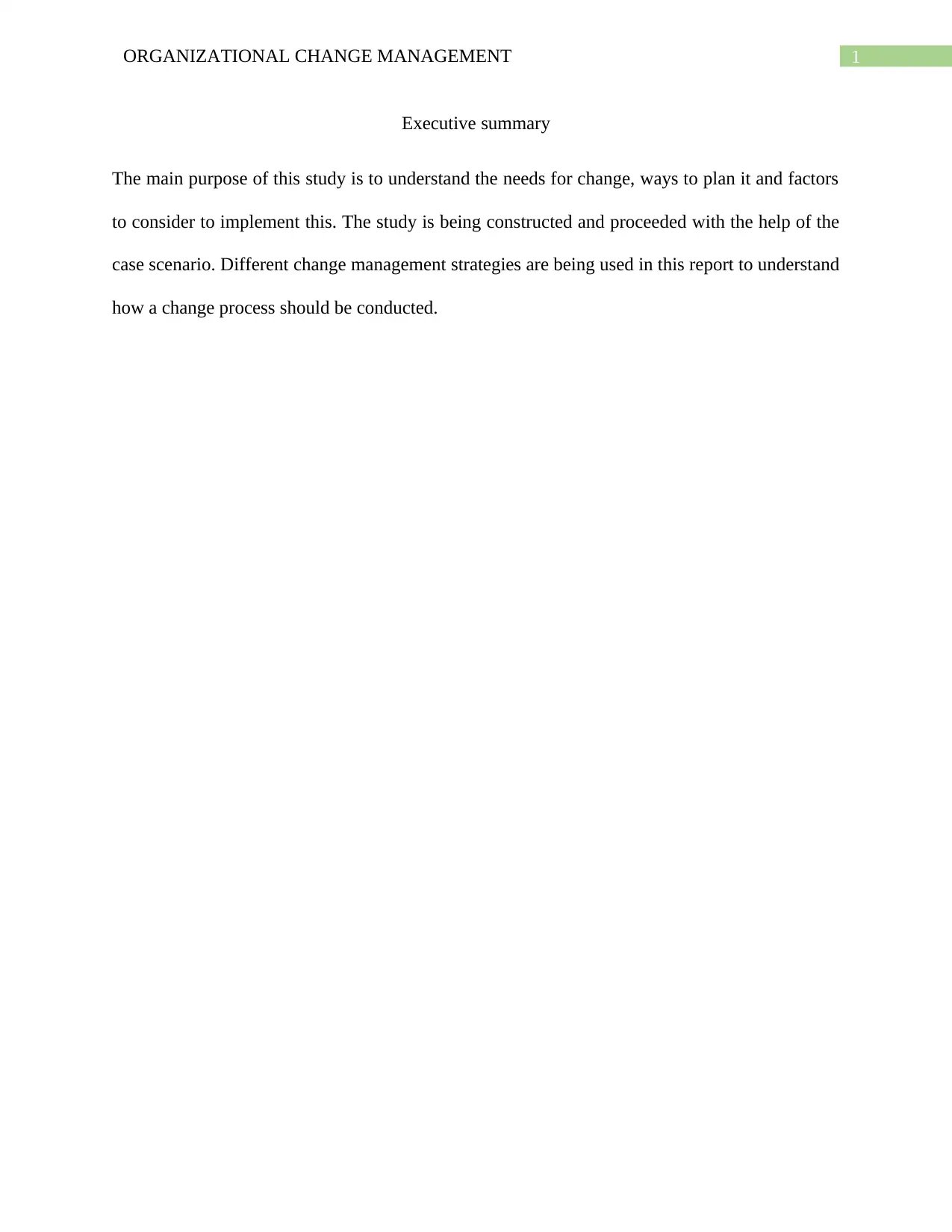
1ORGANIZATIONAL CHANGE MANAGEMENT
Executive summary
The main purpose of this study is to understand the needs for change, ways to plan it and factors
to consider to implement this. The study is being constructed and proceeded with the help of the
case scenario. Different change management strategies are being used in this report to understand
how a change process should be conducted.
Executive summary
The main purpose of this study is to understand the needs for change, ways to plan it and factors
to consider to implement this. The study is being constructed and proceeded with the help of the
case scenario. Different change management strategies are being used in this report to understand
how a change process should be conducted.
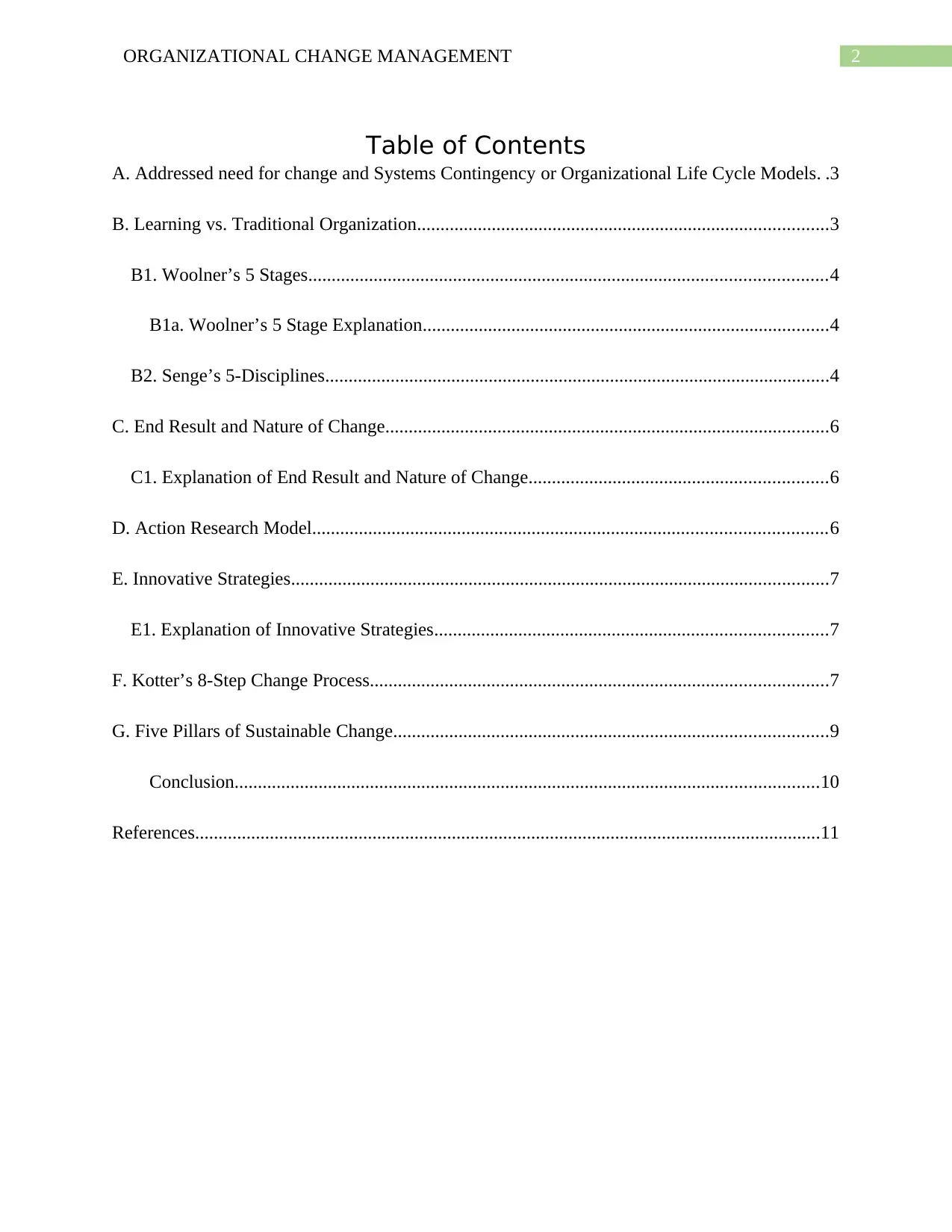
2ORGANIZATIONAL CHANGE MANAGEMENT
Table of Contents
A. Addressed need for change and Systems Contingency or Organizational Life Cycle Models. .3
B. Learning vs. Traditional Organization........................................................................................3
B1. Woolner’s 5 Stages...............................................................................................................4
B1a. Woolner’s 5 Stage Explanation.......................................................................................4
B2. Senge’s 5-Disciplines............................................................................................................4
C. End Result and Nature of Change...............................................................................................6
C1. Explanation of End Result and Nature of Change................................................................6
D. Action Research Model..............................................................................................................6
E. Innovative Strategies...................................................................................................................7
E1. Explanation of Innovative Strategies....................................................................................7
F. Kotter’s 8-Step Change Process..................................................................................................7
G. Five Pillars of Sustainable Change.............................................................................................9
Conclusion.............................................................................................................................10
References......................................................................................................................................11
Table of Contents
A. Addressed need for change and Systems Contingency or Organizational Life Cycle Models. .3
B. Learning vs. Traditional Organization........................................................................................3
B1. Woolner’s 5 Stages...............................................................................................................4
B1a. Woolner’s 5 Stage Explanation.......................................................................................4
B2. Senge’s 5-Disciplines............................................................................................................4
C. End Result and Nature of Change...............................................................................................6
C1. Explanation of End Result and Nature of Change................................................................6
D. Action Research Model..............................................................................................................6
E. Innovative Strategies...................................................................................................................7
E1. Explanation of Innovative Strategies....................................................................................7
F. Kotter’s 8-Step Change Process..................................................................................................7
G. Five Pillars of Sustainable Change.............................................................................................9
Conclusion.............................................................................................................................10
References......................................................................................................................................11
⊘ This is a preview!⊘
Do you want full access?
Subscribe today to unlock all pages.

Trusted by 1+ million students worldwide
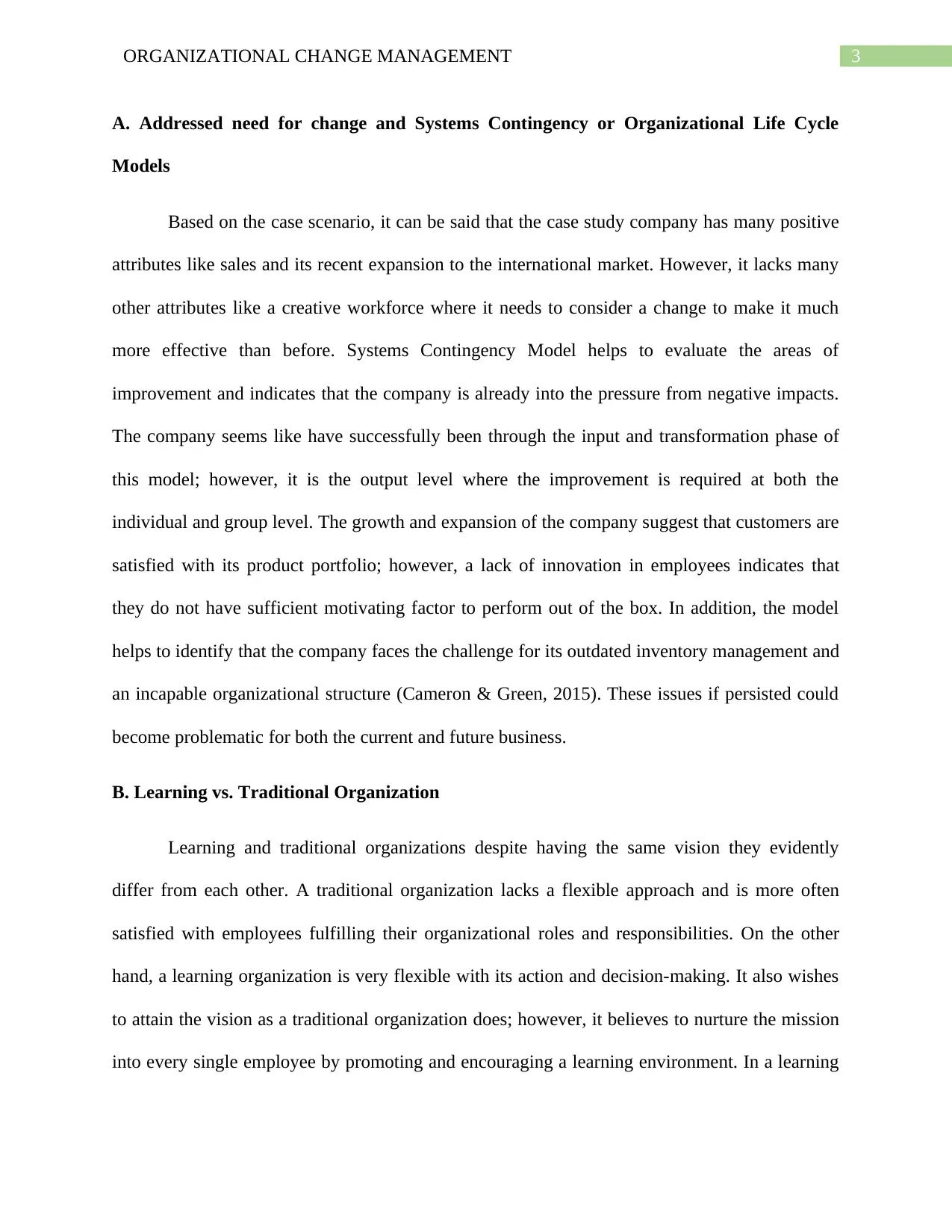
3ORGANIZATIONAL CHANGE MANAGEMENT
A. Addressed need for change and Systems Contingency or Organizational Life Cycle
Models
Based on the case scenario, it can be said that the case study company has many positive
attributes like sales and its recent expansion to the international market. However, it lacks many
other attributes like a creative workforce where it needs to consider a change to make it much
more effective than before. Systems Contingency Model helps to evaluate the areas of
improvement and indicates that the company is already into the pressure from negative impacts.
The company seems like have successfully been through the input and transformation phase of
this model; however, it is the output level where the improvement is required at both the
individual and group level. The growth and expansion of the company suggest that customers are
satisfied with its product portfolio; however, a lack of innovation in employees indicates that
they do not have sufficient motivating factor to perform out of the box. In addition, the model
helps to identify that the company faces the challenge for its outdated inventory management and
an incapable organizational structure (Cameron & Green, 2015). These issues if persisted could
become problematic for both the current and future business.
B. Learning vs. Traditional Organization
Learning and traditional organizations despite having the same vision they evidently
differ from each other. A traditional organization lacks a flexible approach and is more often
satisfied with employees fulfilling their organizational roles and responsibilities. On the other
hand, a learning organization is very flexible with its action and decision-making. It also wishes
to attain the vision as a traditional organization does; however, it believes to nurture the mission
into every single employee by promoting and encouraging a learning environment. In a learning
A. Addressed need for change and Systems Contingency or Organizational Life Cycle
Models
Based on the case scenario, it can be said that the case study company has many positive
attributes like sales and its recent expansion to the international market. However, it lacks many
other attributes like a creative workforce where it needs to consider a change to make it much
more effective than before. Systems Contingency Model helps to evaluate the areas of
improvement and indicates that the company is already into the pressure from negative impacts.
The company seems like have successfully been through the input and transformation phase of
this model; however, it is the output level where the improvement is required at both the
individual and group level. The growth and expansion of the company suggest that customers are
satisfied with its product portfolio; however, a lack of innovation in employees indicates that
they do not have sufficient motivating factor to perform out of the box. In addition, the model
helps to identify that the company faces the challenge for its outdated inventory management and
an incapable organizational structure (Cameron & Green, 2015). These issues if persisted could
become problematic for both the current and future business.
B. Learning vs. Traditional Organization
Learning and traditional organizations despite having the same vision they evidently
differ from each other. A traditional organization lacks a flexible approach and is more often
satisfied with employees fulfilling their organizational roles and responsibilities. On the other
hand, a learning organization is very flexible with its action and decision-making. It also wishes
to attain the vision as a traditional organization does; however, it believes to nurture the mission
into every single employee by promoting and encouraging a learning environment. In a learning
Paraphrase This Document
Need a fresh take? Get an instant paraphrase of this document with our AI Paraphraser
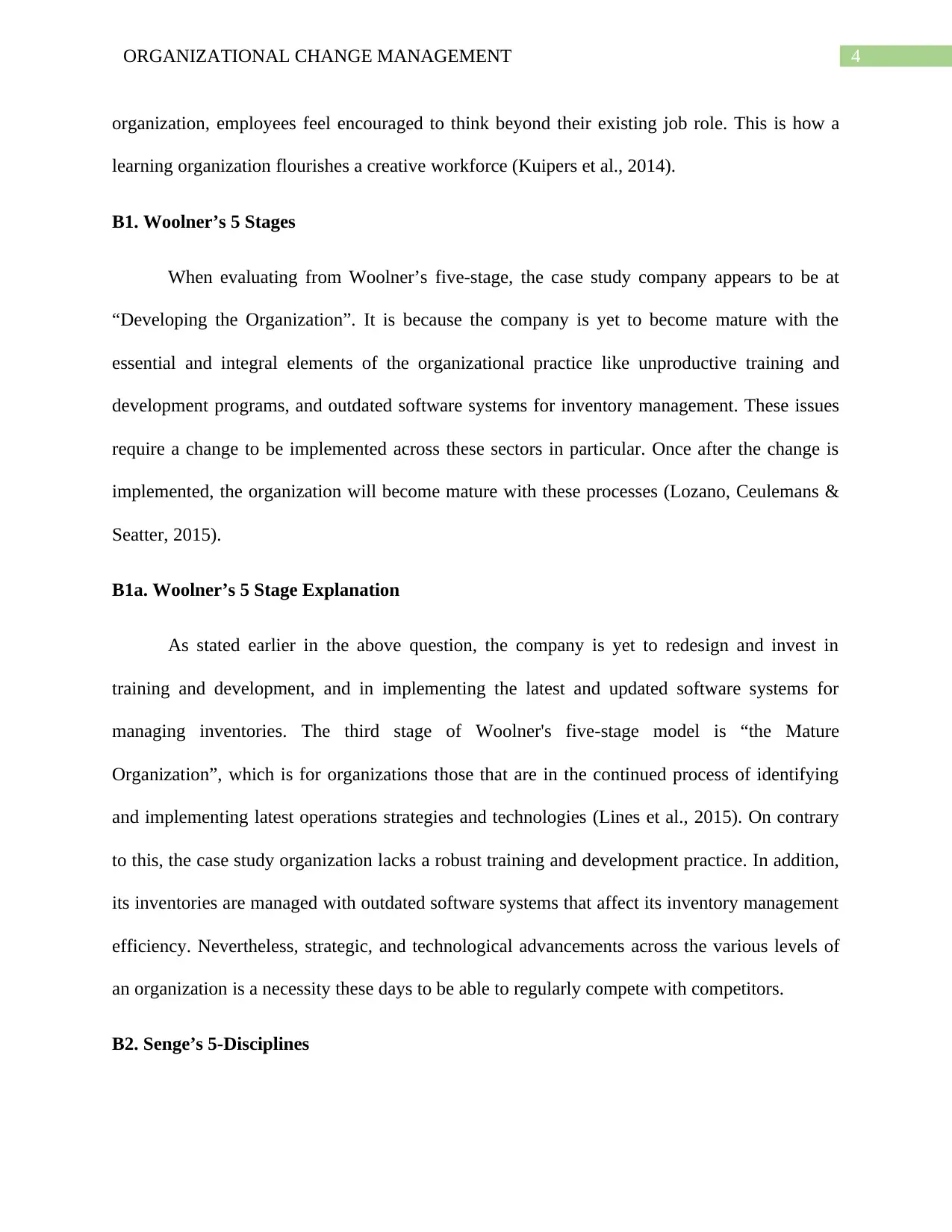
4ORGANIZATIONAL CHANGE MANAGEMENT
organization, employees feel encouraged to think beyond their existing job role. This is how a
learning organization flourishes a creative workforce (Kuipers et al., 2014).
B1. Woolner’s 5 Stages
When evaluating from Woolner’s five-stage, the case study company appears to be at
“Developing the Organization”. It is because the company is yet to become mature with the
essential and integral elements of the organizational practice like unproductive training and
development programs, and outdated software systems for inventory management. These issues
require a change to be implemented across these sectors in particular. Once after the change is
implemented, the organization will become mature with these processes (Lozano, Ceulemans &
Seatter, 2015).
B1a. Woolner’s 5 Stage Explanation
As stated earlier in the above question, the company is yet to redesign and invest in
training and development, and in implementing the latest and updated software systems for
managing inventories. The third stage of Woolner's five-stage model is “the Mature
Organization”, which is for organizations those that are in the continued process of identifying
and implementing latest operations strategies and technologies (Lines et al., 2015). On contrary
to this, the case study organization lacks a robust training and development practice. In addition,
its inventories are managed with outdated software systems that affect its inventory management
efficiency. Nevertheless, strategic, and technological advancements across the various levels of
an organization is a necessity these days to be able to regularly compete with competitors.
B2. Senge’s 5-Disciplines
organization, employees feel encouraged to think beyond their existing job role. This is how a
learning organization flourishes a creative workforce (Kuipers et al., 2014).
B1. Woolner’s 5 Stages
When evaluating from Woolner’s five-stage, the case study company appears to be at
“Developing the Organization”. It is because the company is yet to become mature with the
essential and integral elements of the organizational practice like unproductive training and
development programs, and outdated software systems for inventory management. These issues
require a change to be implemented across these sectors in particular. Once after the change is
implemented, the organization will become mature with these processes (Lozano, Ceulemans &
Seatter, 2015).
B1a. Woolner’s 5 Stage Explanation
As stated earlier in the above question, the company is yet to redesign and invest in
training and development, and in implementing the latest and updated software systems for
managing inventories. The third stage of Woolner's five-stage model is “the Mature
Organization”, which is for organizations those that are in the continued process of identifying
and implementing latest operations strategies and technologies (Lines et al., 2015). On contrary
to this, the case study organization lacks a robust training and development practice. In addition,
its inventories are managed with outdated software systems that affect its inventory management
efficiency. Nevertheless, strategic, and technological advancements across the various levels of
an organization is a necessity these days to be able to regularly compete with competitors.
B2. Senge’s 5-Disciplines
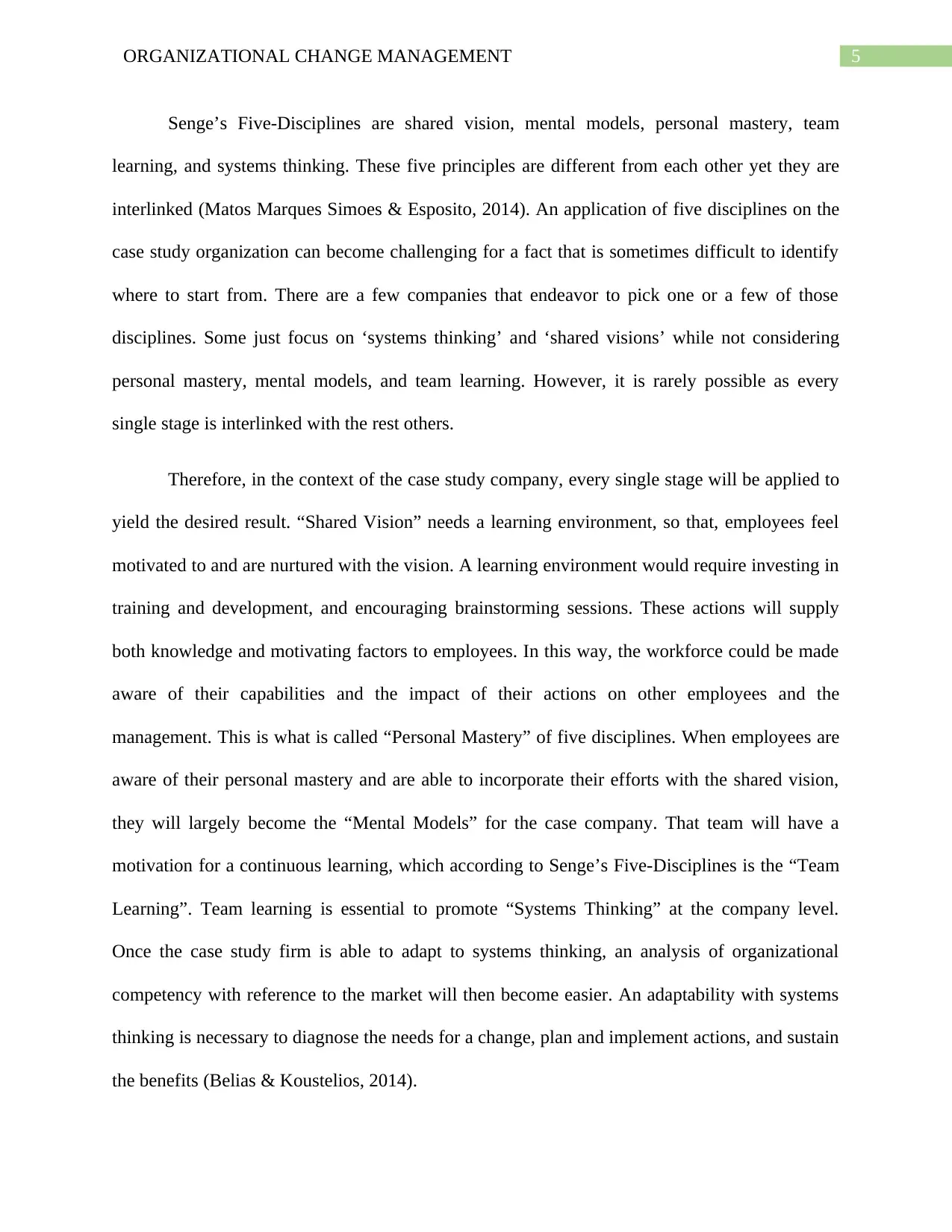
5ORGANIZATIONAL CHANGE MANAGEMENT
Senge’s Five-Disciplines are shared vision, mental models, personal mastery, team
learning, and systems thinking. These five principles are different from each other yet they are
interlinked (Matos Marques Simoes & Esposito, 2014). An application of five disciplines on the
case study organization can become challenging for a fact that is sometimes difficult to identify
where to start from. There are a few companies that endeavor to pick one or a few of those
disciplines. Some just focus on ‘systems thinking’ and ‘shared visions’ while not considering
personal mastery, mental models, and team learning. However, it is rarely possible as every
single stage is interlinked with the rest others.
Therefore, in the context of the case study company, every single stage will be applied to
yield the desired result. “Shared Vision” needs a learning environment, so that, employees feel
motivated to and are nurtured with the vision. A learning environment would require investing in
training and development, and encouraging brainstorming sessions. These actions will supply
both knowledge and motivating factors to employees. In this way, the workforce could be made
aware of their capabilities and the impact of their actions on other employees and the
management. This is what is called “Personal Mastery” of five disciplines. When employees are
aware of their personal mastery and are able to incorporate their efforts with the shared vision,
they will largely become the “Mental Models” for the case company. That team will have a
motivation for a continuous learning, which according to Senge’s Five-Disciplines is the “Team
Learning”. Team learning is essential to promote “Systems Thinking” at the company level.
Once the case study firm is able to adapt to systems thinking, an analysis of organizational
competency with reference to the market will then become easier. An adaptability with systems
thinking is necessary to diagnose the needs for a change, plan and implement actions, and sustain
the benefits (Belias & Koustelios, 2014).
Senge’s Five-Disciplines are shared vision, mental models, personal mastery, team
learning, and systems thinking. These five principles are different from each other yet they are
interlinked (Matos Marques Simoes & Esposito, 2014). An application of five disciplines on the
case study organization can become challenging for a fact that is sometimes difficult to identify
where to start from. There are a few companies that endeavor to pick one or a few of those
disciplines. Some just focus on ‘systems thinking’ and ‘shared visions’ while not considering
personal mastery, mental models, and team learning. However, it is rarely possible as every
single stage is interlinked with the rest others.
Therefore, in the context of the case study company, every single stage will be applied to
yield the desired result. “Shared Vision” needs a learning environment, so that, employees feel
motivated to and are nurtured with the vision. A learning environment would require investing in
training and development, and encouraging brainstorming sessions. These actions will supply
both knowledge and motivating factors to employees. In this way, the workforce could be made
aware of their capabilities and the impact of their actions on other employees and the
management. This is what is called “Personal Mastery” of five disciplines. When employees are
aware of their personal mastery and are able to incorporate their efforts with the shared vision,
they will largely become the “Mental Models” for the case company. That team will have a
motivation for a continuous learning, which according to Senge’s Five-Disciplines is the “Team
Learning”. Team learning is essential to promote “Systems Thinking” at the company level.
Once the case study firm is able to adapt to systems thinking, an analysis of organizational
competency with reference to the market will then become easier. An adaptability with systems
thinking is necessary to diagnose the needs for a change, plan and implement actions, and sustain
the benefits (Belias & Koustelios, 2014).
⊘ This is a preview!⊘
Do you want full access?
Subscribe today to unlock all pages.

Trusted by 1+ million students worldwide
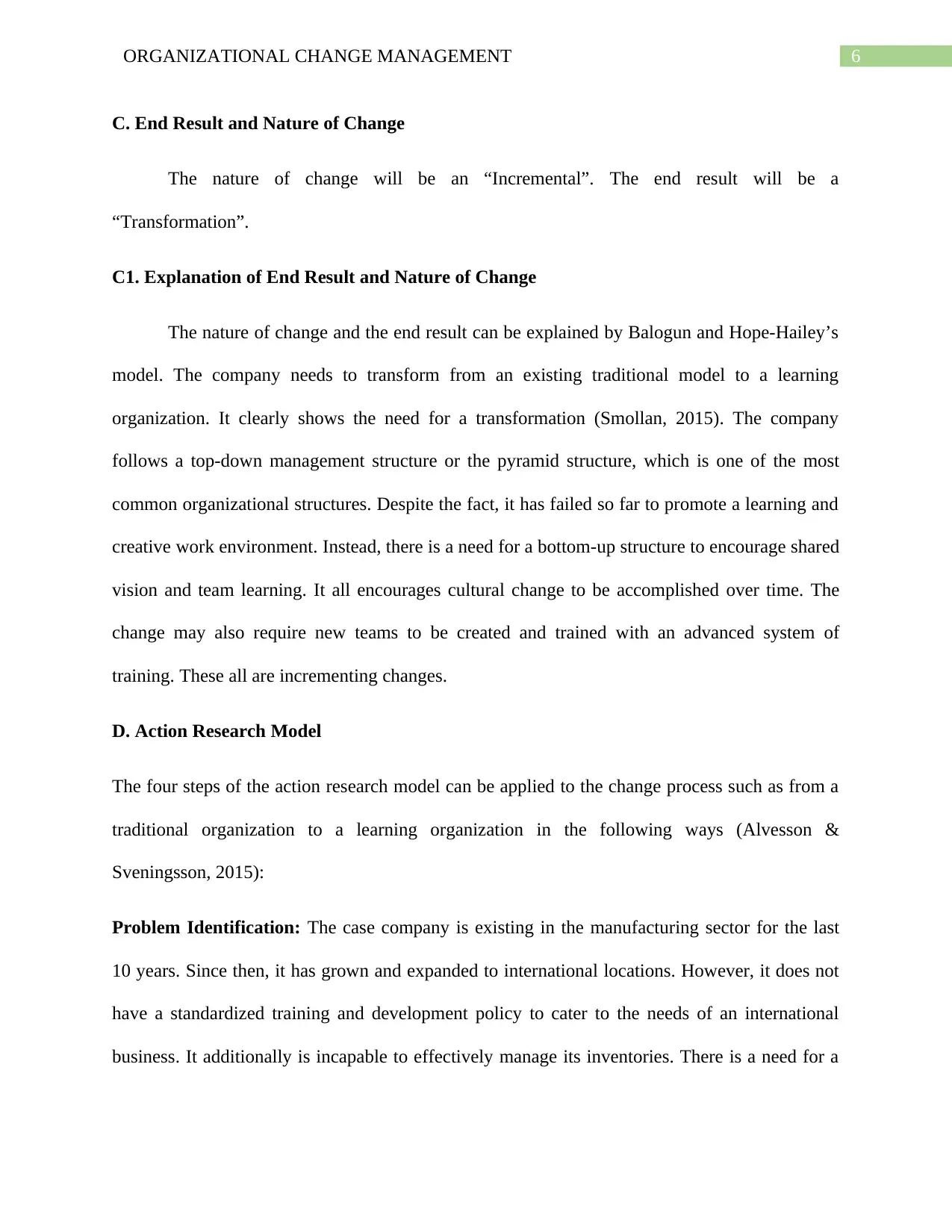
6ORGANIZATIONAL CHANGE MANAGEMENT
C. End Result and Nature of Change
The nature of change will be an “Incremental”. The end result will be a
“Transformation”.
C1. Explanation of End Result and Nature of Change
The nature of change and the end result can be explained by Balogun and Hope-Hailey’s
model. The company needs to transform from an existing traditional model to a learning
organization. It clearly shows the need for a transformation (Smollan, 2015). The company
follows a top-down management structure or the pyramid structure, which is one of the most
common organizational structures. Despite the fact, it has failed so far to promote a learning and
creative work environment. Instead, there is a need for a bottom-up structure to encourage shared
vision and team learning. It all encourages cultural change to be accomplished over time. The
change may also require new teams to be created and trained with an advanced system of
training. These all are incrementing changes.
D. Action Research Model
The four steps of the action research model can be applied to the change process such as from a
traditional organization to a learning organization in the following ways (Alvesson &
Sveningsson, 2015):
Problem Identification: The case company is existing in the manufacturing sector for the last
10 years. Since then, it has grown and expanded to international locations. However, it does not
have a standardized training and development policy to cater to the needs of an international
business. It additionally is incapable to effectively manage its inventories. There is a need for a
C. End Result and Nature of Change
The nature of change will be an “Incremental”. The end result will be a
“Transformation”.
C1. Explanation of End Result and Nature of Change
The nature of change and the end result can be explained by Balogun and Hope-Hailey’s
model. The company needs to transform from an existing traditional model to a learning
organization. It clearly shows the need for a transformation (Smollan, 2015). The company
follows a top-down management structure or the pyramid structure, which is one of the most
common organizational structures. Despite the fact, it has failed so far to promote a learning and
creative work environment. Instead, there is a need for a bottom-up structure to encourage shared
vision and team learning. It all encourages cultural change to be accomplished over time. The
change may also require new teams to be created and trained with an advanced system of
training. These all are incrementing changes.
D. Action Research Model
The four steps of the action research model can be applied to the change process such as from a
traditional organization to a learning organization in the following ways (Alvesson &
Sveningsson, 2015):
Problem Identification: The case company is existing in the manufacturing sector for the last
10 years. Since then, it has grown and expanded to international locations. However, it does not
have a standardized training and development policy to cater to the needs of an international
business. It additionally is incapable to effectively manage its inventories. There is a need for a
Paraphrase This Document
Need a fresh take? Get an instant paraphrase of this document with our AI Paraphraser
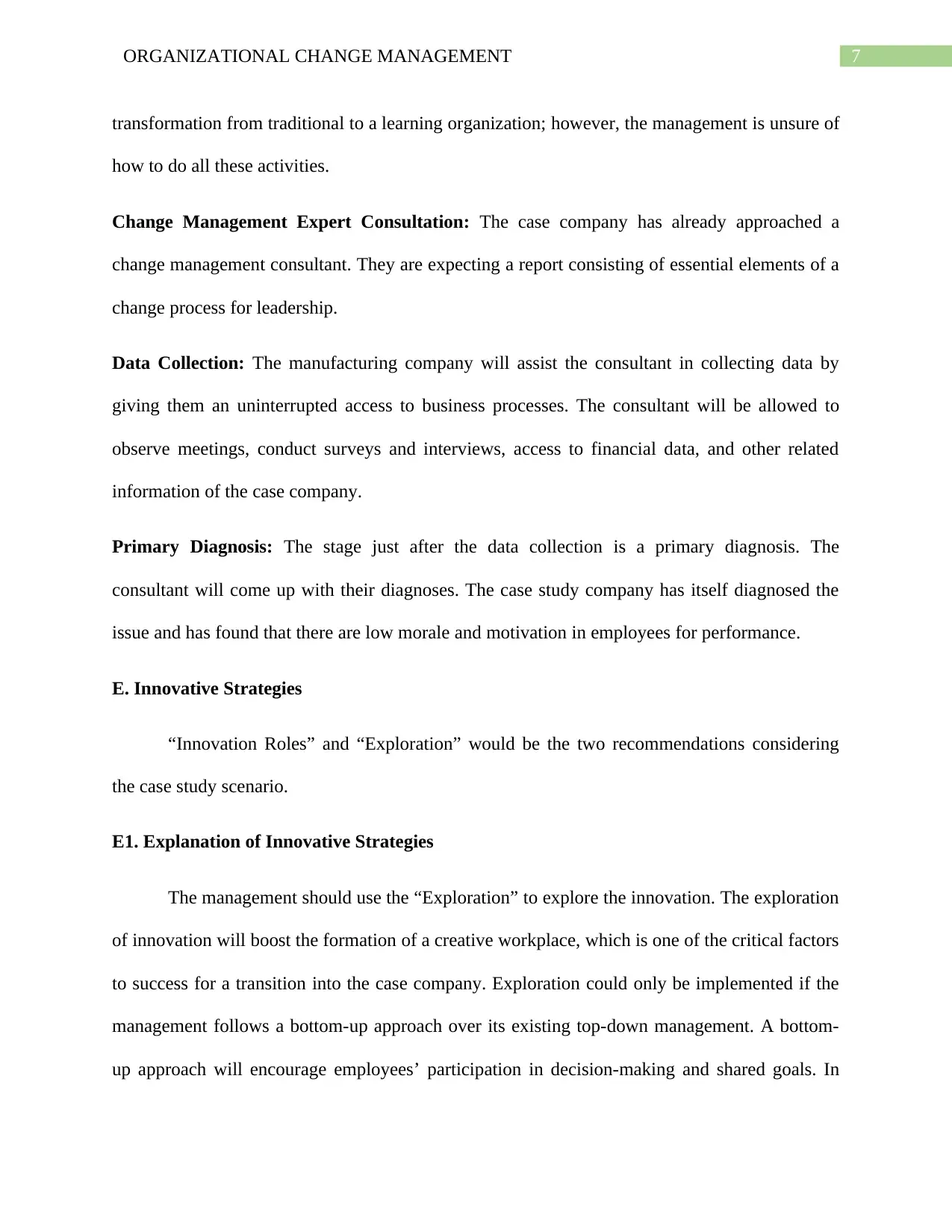
7ORGANIZATIONAL CHANGE MANAGEMENT
transformation from traditional to a learning organization; however, the management is unsure of
how to do all these activities.
Change Management Expert Consultation: The case company has already approached a
change management consultant. They are expecting a report consisting of essential elements of a
change process for leadership.
Data Collection: The manufacturing company will assist the consultant in collecting data by
giving them an uninterrupted access to business processes. The consultant will be allowed to
observe meetings, conduct surveys and interviews, access to financial data, and other related
information of the case company.
Primary Diagnosis: The stage just after the data collection is a primary diagnosis. The
consultant will come up with their diagnoses. The case study company has itself diagnosed the
issue and has found that there are low morale and motivation in employees for performance.
E. Innovative Strategies
“Innovation Roles” and “Exploration” would be the two recommendations considering
the case study scenario.
E1. Explanation of Innovative Strategies
The management should use the “Exploration” to explore the innovation. The exploration
of innovation will boost the formation of a creative workplace, which is one of the critical factors
to success for a transition into the case company. Exploration could only be implemented if the
management follows a bottom-up approach over its existing top-down management. A bottom-
up approach will encourage employees’ participation in decision-making and shared goals. In
transformation from traditional to a learning organization; however, the management is unsure of
how to do all these activities.
Change Management Expert Consultation: The case company has already approached a
change management consultant. They are expecting a report consisting of essential elements of a
change process for leadership.
Data Collection: The manufacturing company will assist the consultant in collecting data by
giving them an uninterrupted access to business processes. The consultant will be allowed to
observe meetings, conduct surveys and interviews, access to financial data, and other related
information of the case company.
Primary Diagnosis: The stage just after the data collection is a primary diagnosis. The
consultant will come up with their diagnoses. The case study company has itself diagnosed the
issue and has found that there are low morale and motivation in employees for performance.
E. Innovative Strategies
“Innovation Roles” and “Exploration” would be the two recommendations considering
the case study scenario.
E1. Explanation of Innovative Strategies
The management should use the “Exploration” to explore the innovation. The exploration
of innovation will boost the formation of a creative workplace, which is one of the critical factors
to success for a transition into the case company. Exploration could only be implemented if the
management follows a bottom-up approach over its existing top-down management. A bottom-
up approach will encourage employees’ participation in decision-making and shared goals. In
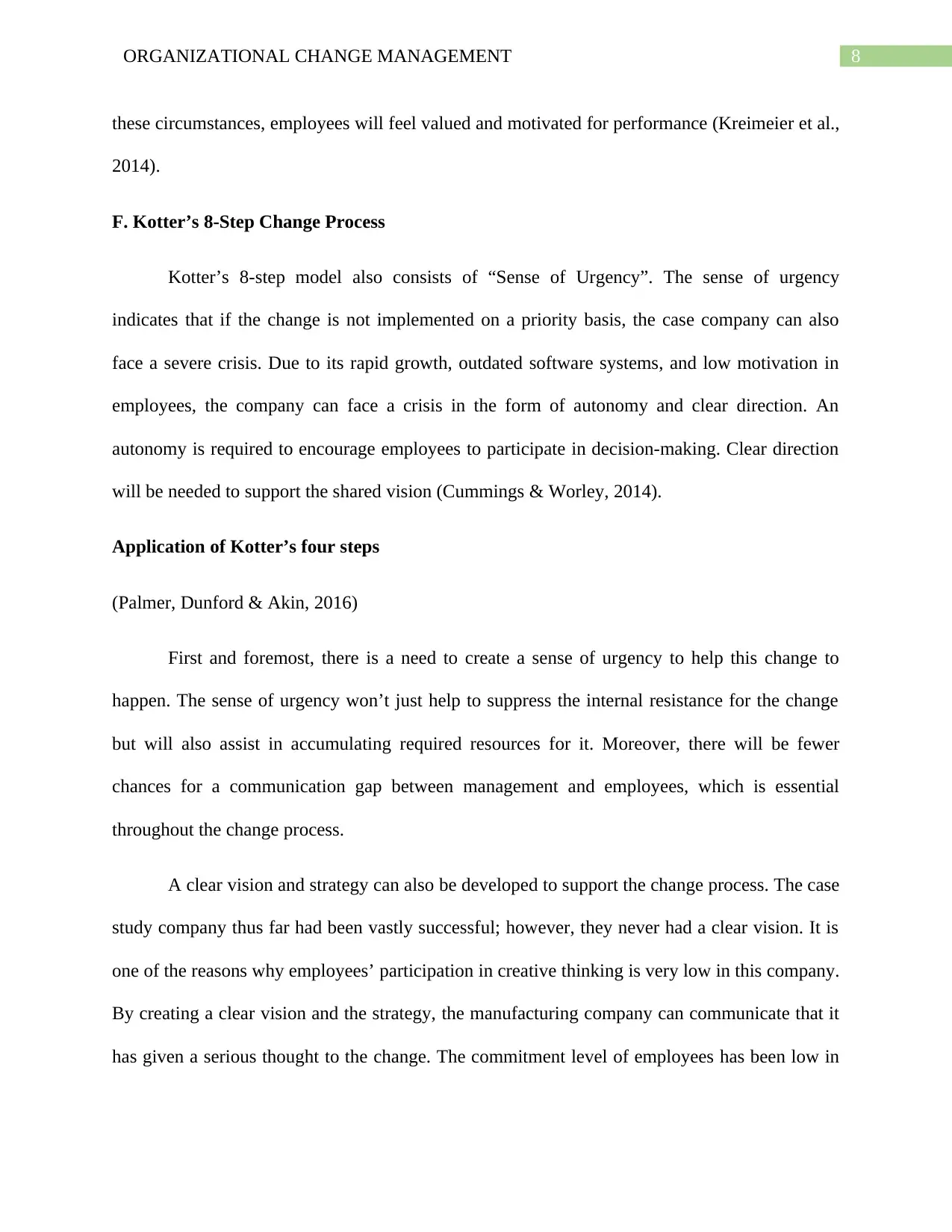
8ORGANIZATIONAL CHANGE MANAGEMENT
these circumstances, employees will feel valued and motivated for performance (Kreimeier et al.,
2014).
F. Kotter’s 8-Step Change Process
Kotter’s 8-step model also consists of “Sense of Urgency”. The sense of urgency
indicates that if the change is not implemented on a priority basis, the case company can also
face a severe crisis. Due to its rapid growth, outdated software systems, and low motivation in
employees, the company can face a crisis in the form of autonomy and clear direction. An
autonomy is required to encourage employees to participate in decision-making. Clear direction
will be needed to support the shared vision (Cummings & Worley, 2014).
Application of Kotter’s four steps
(Palmer, Dunford & Akin, 2016)
First and foremost, there is a need to create a sense of urgency to help this change to
happen. The sense of urgency won’t just help to suppress the internal resistance for the change
but will also assist in accumulating required resources for it. Moreover, there will be fewer
chances for a communication gap between management and employees, which is essential
throughout the change process.
A clear vision and strategy can also be developed to support the change process. The case
study company thus far had been vastly successful; however, they never had a clear vision. It is
one of the reasons why employees’ participation in creative thinking is very low in this company.
By creating a clear vision and the strategy, the manufacturing company can communicate that it
has given a serious thought to the change. The commitment level of employees has been low in
these circumstances, employees will feel valued and motivated for performance (Kreimeier et al.,
2014).
F. Kotter’s 8-Step Change Process
Kotter’s 8-step model also consists of “Sense of Urgency”. The sense of urgency
indicates that if the change is not implemented on a priority basis, the case company can also
face a severe crisis. Due to its rapid growth, outdated software systems, and low motivation in
employees, the company can face a crisis in the form of autonomy and clear direction. An
autonomy is required to encourage employees to participate in decision-making. Clear direction
will be needed to support the shared vision (Cummings & Worley, 2014).
Application of Kotter’s four steps
(Palmer, Dunford & Akin, 2016)
First and foremost, there is a need to create a sense of urgency to help this change to
happen. The sense of urgency won’t just help to suppress the internal resistance for the change
but will also assist in accumulating required resources for it. Moreover, there will be fewer
chances for a communication gap between management and employees, which is essential
throughout the change process.
A clear vision and strategy can also be developed to support the change process. The case
study company thus far had been vastly successful; however, they never had a clear vision. It is
one of the reasons why employees’ participation in creative thinking is very low in this company.
By creating a clear vision and the strategy, the manufacturing company can communicate that it
has given a serious thought to the change. The commitment level of employees has been low in
⊘ This is a preview!⊘
Do you want full access?
Subscribe today to unlock all pages.

Trusted by 1+ million students worldwide
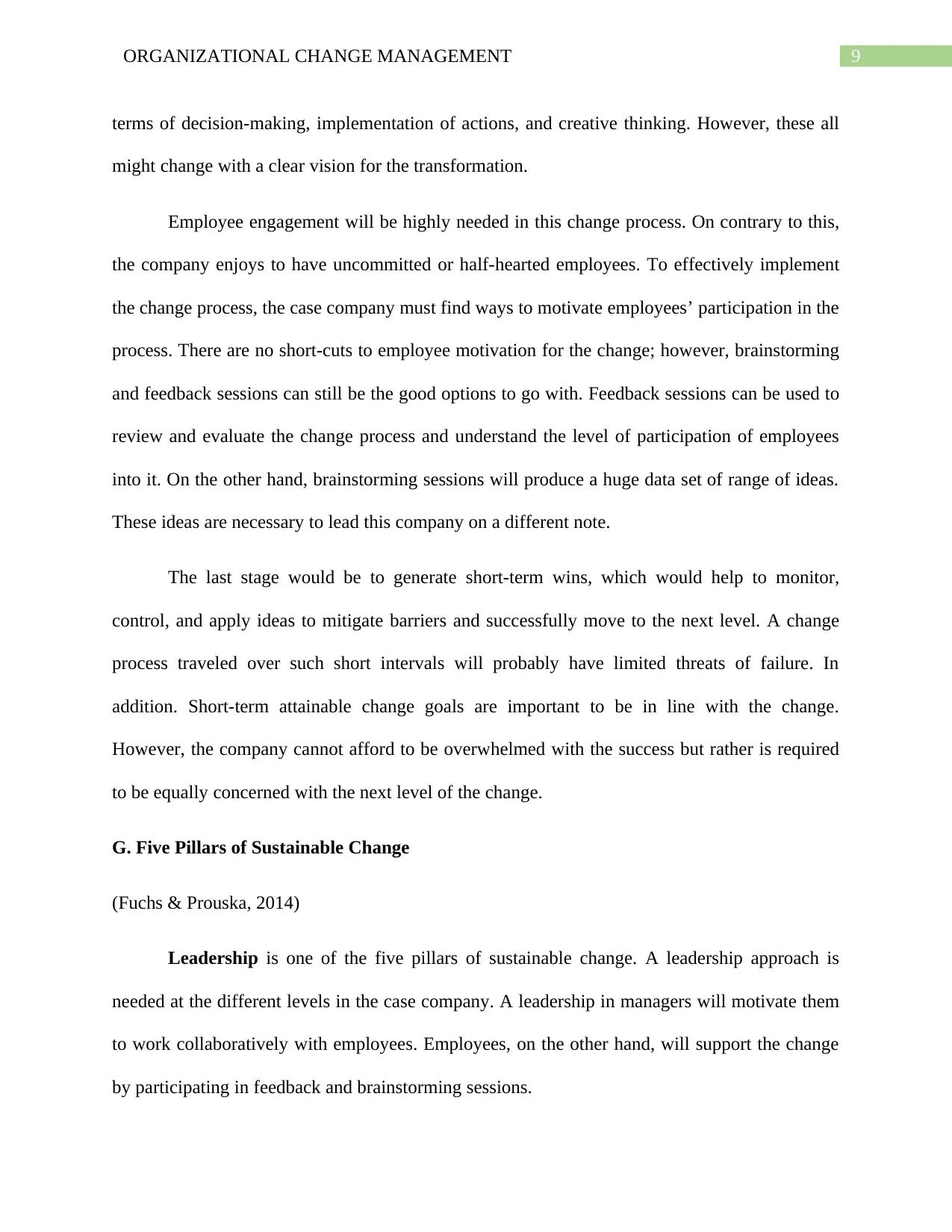
9ORGANIZATIONAL CHANGE MANAGEMENT
terms of decision-making, implementation of actions, and creative thinking. However, these all
might change with a clear vision for the transformation.
Employee engagement will be highly needed in this change process. On contrary to this,
the company enjoys to have uncommitted or half-hearted employees. To effectively implement
the change process, the case company must find ways to motivate employees’ participation in the
process. There are no short-cuts to employee motivation for the change; however, brainstorming
and feedback sessions can still be the good options to go with. Feedback sessions can be used to
review and evaluate the change process and understand the level of participation of employees
into it. On the other hand, brainstorming sessions will produce a huge data set of range of ideas.
These ideas are necessary to lead this company on a different note.
The last stage would be to generate short-term wins, which would help to monitor,
control, and apply ideas to mitigate barriers and successfully move to the next level. A change
process traveled over such short intervals will probably have limited threats of failure. In
addition. Short-term attainable change goals are important to be in line with the change.
However, the company cannot afford to be overwhelmed with the success but rather is required
to be equally concerned with the next level of the change.
G. Five Pillars of Sustainable Change
(Fuchs & Prouska, 2014)
Leadership is one of the five pillars of sustainable change. A leadership approach is
needed at the different levels in the case company. A leadership in managers will motivate them
to work collaboratively with employees. Employees, on the other hand, will support the change
by participating in feedback and brainstorming sessions.
terms of decision-making, implementation of actions, and creative thinking. However, these all
might change with a clear vision for the transformation.
Employee engagement will be highly needed in this change process. On contrary to this,
the company enjoys to have uncommitted or half-hearted employees. To effectively implement
the change process, the case company must find ways to motivate employees’ participation in the
process. There are no short-cuts to employee motivation for the change; however, brainstorming
and feedback sessions can still be the good options to go with. Feedback sessions can be used to
review and evaluate the change process and understand the level of participation of employees
into it. On the other hand, brainstorming sessions will produce a huge data set of range of ideas.
These ideas are necessary to lead this company on a different note.
The last stage would be to generate short-term wins, which would help to monitor,
control, and apply ideas to mitigate barriers and successfully move to the next level. A change
process traveled over such short intervals will probably have limited threats of failure. In
addition. Short-term attainable change goals are important to be in line with the change.
However, the company cannot afford to be overwhelmed with the success but rather is required
to be equally concerned with the next level of the change.
G. Five Pillars of Sustainable Change
(Fuchs & Prouska, 2014)
Leadership is one of the five pillars of sustainable change. A leadership approach is
needed at the different levels in the case company. A leadership in managers will motivate them
to work collaboratively with employees. Employees, on the other hand, will support the change
by participating in feedback and brainstorming sessions.
Paraphrase This Document
Need a fresh take? Get an instant paraphrase of this document with our AI Paraphraser
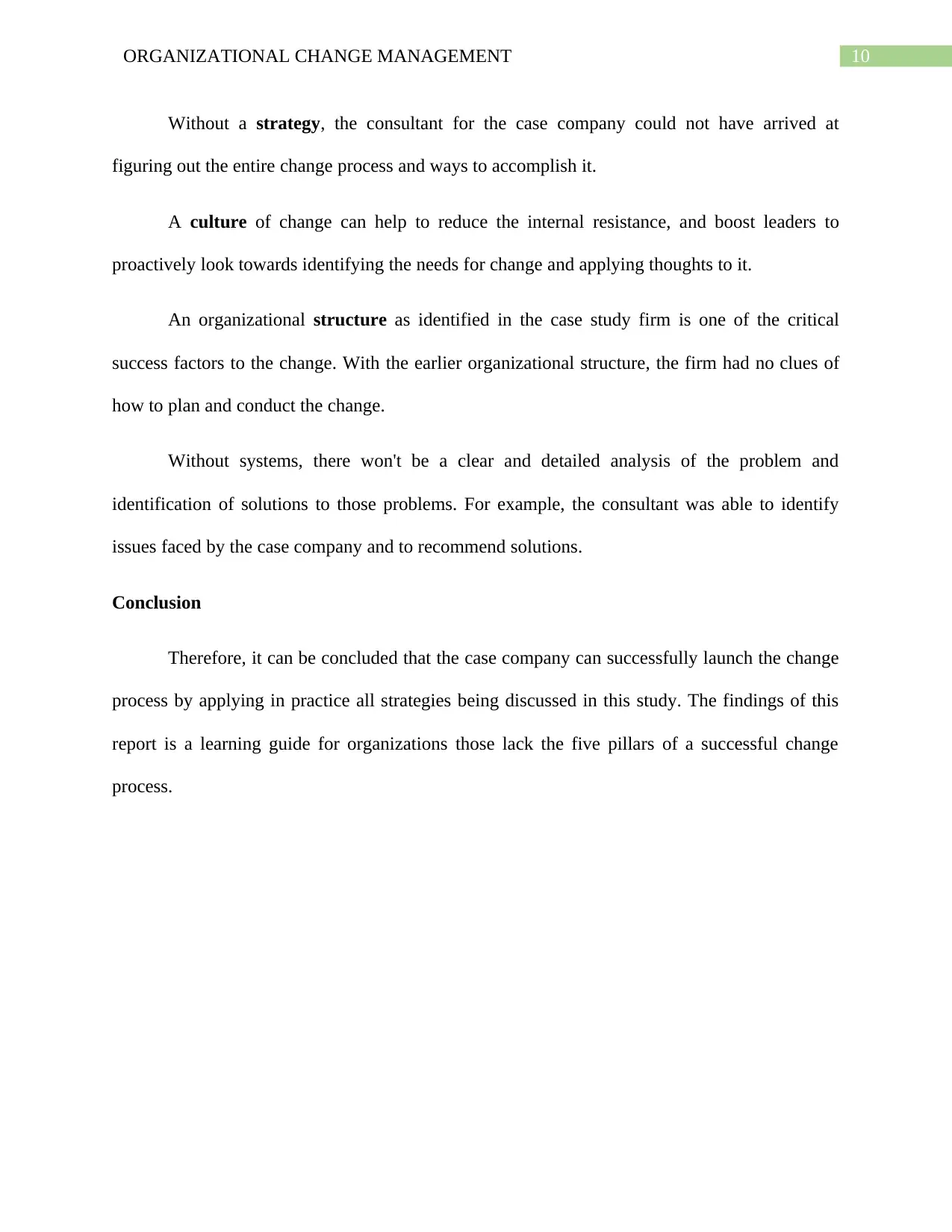
10ORGANIZATIONAL CHANGE MANAGEMENT
Without a strategy, the consultant for the case company could not have arrived at
figuring out the entire change process and ways to accomplish it.
A culture of change can help to reduce the internal resistance, and boost leaders to
proactively look towards identifying the needs for change and applying thoughts to it.
An organizational structure as identified in the case study firm is one of the critical
success factors to the change. With the earlier organizational structure, the firm had no clues of
how to plan and conduct the change.
Without systems, there won't be a clear and detailed analysis of the problem and
identification of solutions to those problems. For example, the consultant was able to identify
issues faced by the case company and to recommend solutions.
Conclusion
Therefore, it can be concluded that the case company can successfully launch the change
process by applying in practice all strategies being discussed in this study. The findings of this
report is a learning guide for organizations those lack the five pillars of a successful change
process.
Without a strategy, the consultant for the case company could not have arrived at
figuring out the entire change process and ways to accomplish it.
A culture of change can help to reduce the internal resistance, and boost leaders to
proactively look towards identifying the needs for change and applying thoughts to it.
An organizational structure as identified in the case study firm is one of the critical
success factors to the change. With the earlier organizational structure, the firm had no clues of
how to plan and conduct the change.
Without systems, there won't be a clear and detailed analysis of the problem and
identification of solutions to those problems. For example, the consultant was able to identify
issues faced by the case company and to recommend solutions.
Conclusion
Therefore, it can be concluded that the case company can successfully launch the change
process by applying in practice all strategies being discussed in this study. The findings of this
report is a learning guide for organizations those lack the five pillars of a successful change
process.
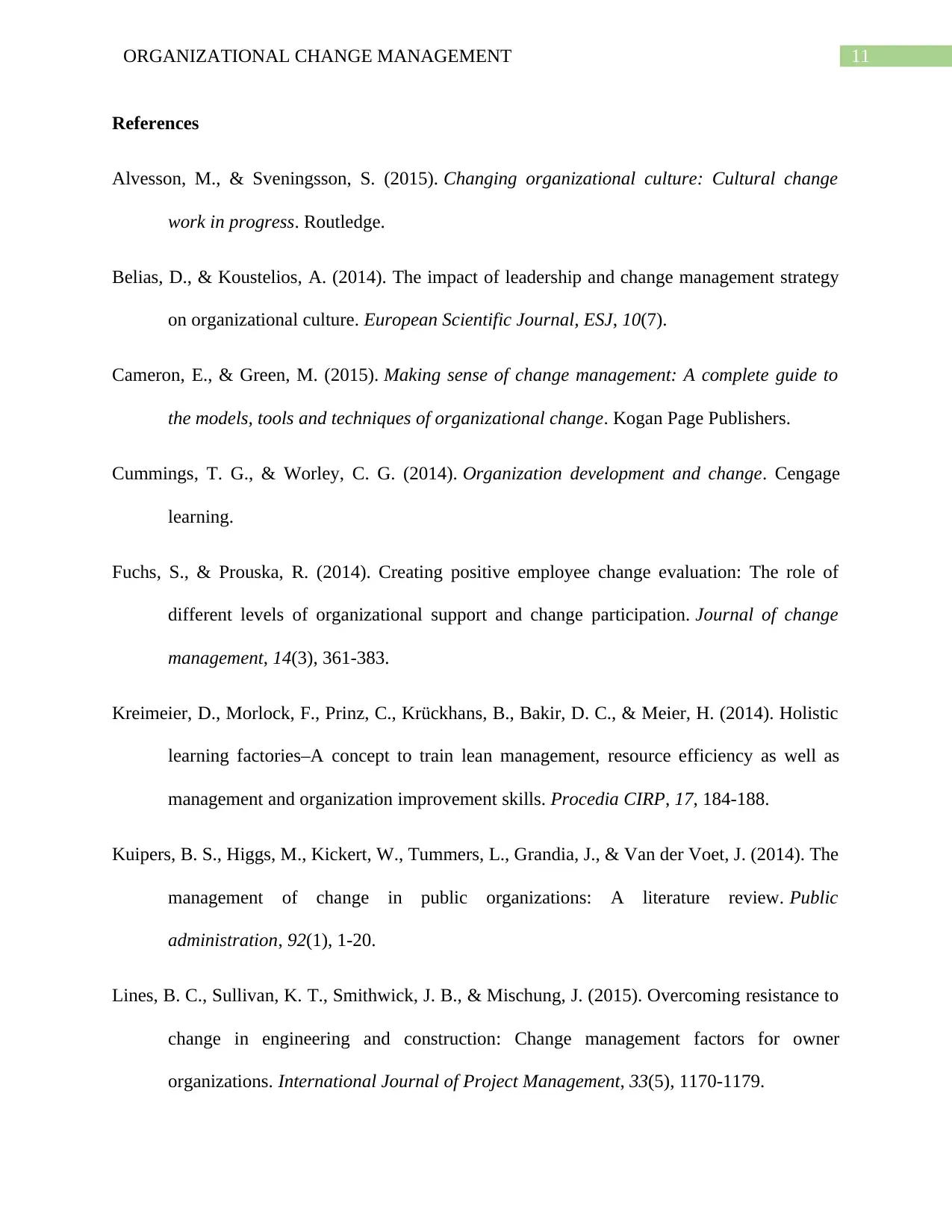
11ORGANIZATIONAL CHANGE MANAGEMENT
References
Alvesson, M., & Sveningsson, S. (2015). Changing organizational culture: Cultural change
work in progress. Routledge.
Belias, D., & Koustelios, A. (2014). The impact of leadership and change management strategy
on organizational culture. European Scientific Journal, ESJ, 10(7).
Cameron, E., & Green, M. (2015). Making sense of change management: A complete guide to
the models, tools and techniques of organizational change. Kogan Page Publishers.
Cummings, T. G., & Worley, C. G. (2014). Organization development and change. Cengage
learning.
Fuchs, S., & Prouska, R. (2014). Creating positive employee change evaluation: The role of
different levels of organizational support and change participation. Journal of change
management, 14(3), 361-383.
Kreimeier, D., Morlock, F., Prinz, C., Krückhans, B., Bakir, D. C., & Meier, H. (2014). Holistic
learning factories–A concept to train lean management, resource efficiency as well as
management and organization improvement skills. Procedia CIRP, 17, 184-188.
Kuipers, B. S., Higgs, M., Kickert, W., Tummers, L., Grandia, J., & Van der Voet, J. (2014). The
management of change in public organizations: A literature review. Public
administration, 92(1), 1-20.
Lines, B. C., Sullivan, K. T., Smithwick, J. B., & Mischung, J. (2015). Overcoming resistance to
change in engineering and construction: Change management factors for owner
organizations. International Journal of Project Management, 33(5), 1170-1179.
References
Alvesson, M., & Sveningsson, S. (2015). Changing organizational culture: Cultural change
work in progress. Routledge.
Belias, D., & Koustelios, A. (2014). The impact of leadership and change management strategy
on organizational culture. European Scientific Journal, ESJ, 10(7).
Cameron, E., & Green, M. (2015). Making sense of change management: A complete guide to
the models, tools and techniques of organizational change. Kogan Page Publishers.
Cummings, T. G., & Worley, C. G. (2014). Organization development and change. Cengage
learning.
Fuchs, S., & Prouska, R. (2014). Creating positive employee change evaluation: The role of
different levels of organizational support and change participation. Journal of change
management, 14(3), 361-383.
Kreimeier, D., Morlock, F., Prinz, C., Krückhans, B., Bakir, D. C., & Meier, H. (2014). Holistic
learning factories–A concept to train lean management, resource efficiency as well as
management and organization improvement skills. Procedia CIRP, 17, 184-188.
Kuipers, B. S., Higgs, M., Kickert, W., Tummers, L., Grandia, J., & Van der Voet, J. (2014). The
management of change in public organizations: A literature review. Public
administration, 92(1), 1-20.
Lines, B. C., Sullivan, K. T., Smithwick, J. B., & Mischung, J. (2015). Overcoming resistance to
change in engineering and construction: Change management factors for owner
organizations. International Journal of Project Management, 33(5), 1170-1179.
⊘ This is a preview!⊘
Do you want full access?
Subscribe today to unlock all pages.

Trusted by 1+ million students worldwide
1 out of 13
Related Documents
Your All-in-One AI-Powered Toolkit for Academic Success.
+13062052269
info@desklib.com
Available 24*7 on WhatsApp / Email
![[object Object]](/_next/static/media/star-bottom.7253800d.svg)
Unlock your academic potential
Copyright © 2020–2025 A2Z Services. All Rights Reserved. Developed and managed by ZUCOL.




